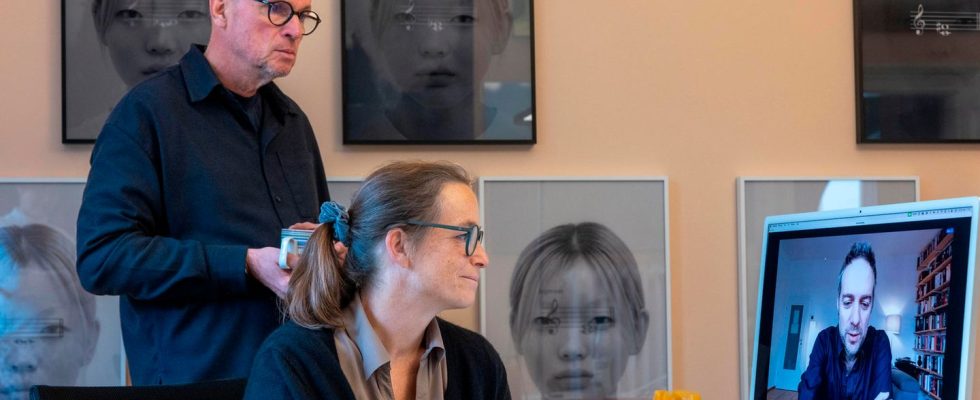Suicide prevention
Emil was 16 when he died – his family is talking about his suicide to help others
Alix and her husband Oliver Puhl lost their son – he took his own life. Author Martin Schäuble tells his story in a novel
© Helmut Fricke / DPA
What to do if your own child commits suicide? For the Puhl family from Frankfurt, the answer is to talk about the death of their son Emil. They want more talk about suicide prevention and mental illnesses to be recognized more easily.
“If we had known then what we know today, things might have turned out differently,” says Alix Puhl. Back then – that is the period before Emil’s death. In the Corona summer of 2020, one of the four children in the Frankfurt family took his own life at the age of 16. “So that others can be spared what Emil had to suffer,” the Puhls go public. They want to help ensure that mental illnesses are recognized earlier.
Emil was special, says his mother in the kitchen, where there are only five chairs around the large dining table instead of six. Emil had a form of autism that is common in gifted people and recently suffered from severe depression – neither of which was clear to his parents for a long time. Martin Schäuble’s young adult novel “All Colors Gray” (Fischer Verlag) attempts to put oneself in the shoes of such a child. Even if the protagonist’s name is “Paul” and details have been distorted, it is still Emil’s story. Alix Puhl hopes that the book will be “a door to start a conversation.”
Suicide in children and adolescents
The fact that the Puhls didn’t want to remain silent has to do with their experiences after Emil’s death. “So many people came to us and told us about suicides in their environment,” says Puhl. “Many said: This is the first time I’ve talked about this. But please don’t tell anyone.” Author Martin Schäuble (“Black Box Jihad”) has also had similar experiences since the novel “All Colors Gray” was published in August, as he reports in an interview.
The contact between the author and the family came about through mutual acquaintances. The impetus was the memorial service on the first anniversary of Emil’s death, at which the parents read a letter to their dead son. Schäuble got to know the Puhls through this mediation and was impressed by how “ruthless and honest” they were.
For months he talked to family, friends, teachers. A non-fiction book was out of the question for him. “With a novel you have the chance to reach many more people. But I also wanted real people: you can learn the most from them.” There is now also a stage version, but no date for a premiere yet.
Little attention in society
Like the Puhls, Schäuble also senses how fearful many people are of confronting this issue. “The topic isn’t big, it’s huge. And yet – or maybe because of that – it’s damn difficult to talk about.” He wants to build trust in readings and interviews: “Just because you don’t talk about it doesn’t mean the topic goes away. You don’t have to be afraid of this book.”
In “All Colors Gray” the act itself – as well as a previous announcement – is completely left out. At the point where “Paul” commits suicide in the novel, the publisher has inserted two black pages. “Very few people know what happened on these pages,” says Alix Puhl.
In Germany, more people die from suicide than from traffic accidents, acts of violence, illegal drugs and AIDS combined, explains the German Society for Suicide Prevention (DGS). And for every suicide, statistically speaking, there are 10 to 20 suicide attempts. “Suicidal behavior is therefore a topic that deserves much greater attention,” says the DGS.
The risk of suicide increases statistically with increasing age. But according to the DGS, suicide is the second most common cause of death worldwide in the 15 to 25 year old age group. According to the Federal Statistical Office, 172 young people between the ages of 15 and 20 and 20 children under the age of 14 committed suicide in Germany in 2022. “Scientists assume that many people who die by suicide were suffering from a mental illness at the time,” says the DGS.
Pictures
Detect mental illnesses earlier
That’s why the Puhls want to clarify. They founded a non-profit company that offers training to detect mental illnesses earlier. Emil’s empty room became an office. Meanwhile, “tomoni mental health” ten employees. Also for them Foundation that the Puhls had already founded in 2015, suicide prevention is now an important field of activity.
Andreas Reif, director of the Clinic for Psychiatry, Psychosomatics and Psychotherapy at the University Hospital Frankfurt, finds this approach “very useful and worth supporting.” It is known that better knowledge about mental illnesses in the school environment leads to better dealing with those affected and therefore also to a better course of the illness. However, there is no systematic training on this topic, says the expert, who also sits on the scientific advisory board of “tomoni”.
450 teachers have already taken part in the online training courses. Various foundations are currently covering the costs. In 2024, “tomoni” wants to offer modules for parents and, in the third step, develop a program for young people. Two versions of the training modules are currently being scientifically evaluated. The Würzburg University Hospital compares what works better: when those affected or when scientists give presentations.


